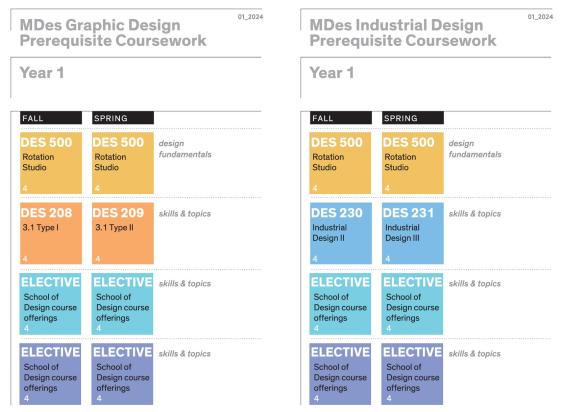The field of design continues to expand in exciting and unprecedented ways. The increasingly complex challenges designers embrace are not only changing the nature of what designers do but how disciplinary knowledge in design is understood. We offer a path to our graduate program that embraces this evolving reality by welcoming applicants without traditional design backgrounds and considering areas of post-secondary study, non-academic activities, professional experience, and stated aims alongside evidence of visual production and critical cultural engagement.
Motivated applicants who do not hold a bachelor’s degree in design or a related discipline may plan for an additional year of prerequisite coursework, which is structured as an inquiry-based immersion in studio practices. An interdisciplinary rotation studio provides the necessary preparation for graduate study in design by introducing students to various design methodologies as they conduct basic investigations into cultural and disciplinary contexts. Simultaneously, students enroll in graduate and advanced undergraduate courses that introduce fundamental technical approaches, research strategies, special topics in design, and more.
Applicants from non-design backgrounds are required to submit a standard MDes application designating a field of interest in Graphic Design or Industrial Design. Upon successful completion of prerequisite coursework, accepted students are automatically enrolled in the two-year MDes program.
EXPECTATIONS FOR APPLICATION PORTFOLIO
Generally speaking, we look for evidence of work that demonstrates an active interest in design. This can take the form of work produced in an extension course in art or design such as work made in a drawing class or images that depict an applicant’s hobby related to design. Occasionally applicants share professional work (such as stationery, reports, or presentations) that incorporate formal decisions or indicate an interest in information design. Some applicants include photography, others present undergraduate degree projects that illuminate their application in a particular way.
For applicants from non-design backgrounds, we place equal weight on the portfolio and written statement and look closely at both to determine their promise as a practitioner and critical thinker. Your essay should clearly indicate an interest in and path to design. How do you understand design? We want to know your vision (to the extent you know it now) and the ways in which it connects with or derives from your previous experience.
